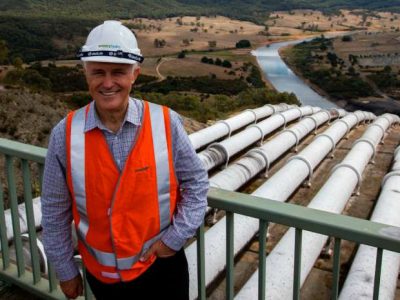Jack Mintz: It’s climate-policy power pandemonium Down Under. Sound familiar?

Australian Prime Minister Malcolm Turnbull visiting the Tumut 3 power station at the Snowy Hydro Scheme in Talbingo, in the Snowy Mountains. Photo by Sahlan Hayes/AFP
CANBERRA, AUSTRALIA – Australia has joined the club of power-market pandemonium created by heavy-handed government intervention. Wholesale electricity prices have doubled, equivalent to a $50-per-tonne carbon tax. Investment has come up short after Australia decommissioned 10 per cent of its power capacity since 2012.
More bad news is expected. Consumers in the populated states will face power shortages for the next seven years, like the recent statewide blackout in South Australia.
The Australian government, deluged with complaints about its inaction, announced on March 16th a proposal for new natural gas power plants and an expansion of the Snowy Mountain hydro-electric system, a day after the premier of South Australia proposed its own action plan in response to its own developing energy and political crisis.
As in so many other jurisdictions, including Ontario, these problems result from inept command-and-control models. After Australian voters rebelled against an attempt to impose carbon taxes, authorities pushed for a bevy of regulations to curb emissions. State governments introduced aggressive renewable-energy targets for large and small producers. The state of Victoria requires renewable energy to account for 40 per cent of power by 2025. Queensland requires 50 per cent renewable energy by 2030. New South Wales has adopted a zero-carbon target by 2050 and the Australian Capital Territory, home to the national government, is the most aggressive having already mandated 100 per cent renewable power in 2016 (backed by base power, of course, and costing massive subsidies).
These mandates are in addition to subsidies for renewable investments and research. In the past decade, the states have also introduced feed-in-tariff schemes for businesses and households to slap solar panels on rooftops at subsidized prices.
After committing to so much renewable power, much of it intermittent wind and solar, Australia closed 12 coal plants over the past five years, the most recent, Hazelwood in Victoria, accounting for five per cent of the national power supply.
The loss in cheap coal-fired electricity has meant finding another supply of base energy to ensure reliability when the wind is not blowing and the sun is not shining. And even though Australia has other options, including abundant nuclear energy (as well as clean coal, which is now estimated to cost the same as solar power), regulators have opted for natural gas, which is both reliable and, most importantly, politically acceptable.
The trouble is that while Australia has abundant natural gas reserves, it’s the lack of supply that is today causing so much pandemonium. State governments, especially the populous New South Wales (Sydney) and Victoria (Melbourne), restrict on-shore natural gas development.
Meanwhile, Australia’s strength in exporting liquefied natural gas (LNG) has meant that local prices now match the global marketplace. Since that sometimes makes natural gas power more costly than subsidized renewable power, investors have been reluctant to invest in gas plants that would have to compete with government-funded green producers.
Not surprisingly, environmentalists blame the problem on the LNG exports, which keep Australia’s gas from suffering a discount for being landlocked. That way they can blame resource companies rather than acknowledging the obvious points that government rules requiring green energy and restricting gas production are badly distorting the market. Prime Minister Malcolm Turnbull is threatening to declare a Banana Republic of Australia by introducing rules that would require East Coast natural gas producers to sacrifice profitable exports and force them to sell gas locally.
Already, some industry players have partly buckled, guaranteeing local supply to at least satisfy peak-time demand, even though that won’t reduce power prices at current elevated levels. Turnbull could still decide to sacrifice Australian wealth by putting a cap on LNG exports to push down natural gas prices in Australia.
The subsidy costs for all these interventionist policies are ballooning. A recent comprehensive report by BAEconomics estimates total renewable energy subsidies total $3 billion (all figures Australian) in 2015–16, roughly doubling in five years. About two-thirds of the subsidy cost is due to renewable energy targets and the balance from feed-in-tariff schemes and grant programs. Overall, every Australian is already paying $150 annually through higher energy prices or taxes.
It ain’t over yet. The Turnbull plan for hydro development announced March 16 is brilliant politics, but expensive policy, requiring $2 billion as an initial estimate, to be covered by the federal government, New South Wales and Victoria. Turnbull correctly argues that the hydro capital cost and reliability is better than an expensive storage-battery project promised by South Australia. Nonetheless, the capital costs will pick the pockets of either ratepayers or taxpayers.
It is not surprising that energy policy has dominated the political airwaves of the past two weeks in Australia, swamping debate over any other political issues. For example, one issue drowned out by the power pandemonium is the federal government’s plan stalled plan to reduce its uncompetitive corporate income tax rate. With surging power prices layered on an already uncompetitive corporate tax system, the business community frets about the deindustrialization of Down Under.
With federal and provincial budgets in Canada being announced, the tax-and-spend virtuosity of Canadian governments with their willingness to use central command-and-control energy policies seem little different than the Australian experience. If Canada wants to avoid the great sucking sound as investment flees to the U.S., it had better do everything it can to avoid the Australian energy debacle.
Source: Financial Post


